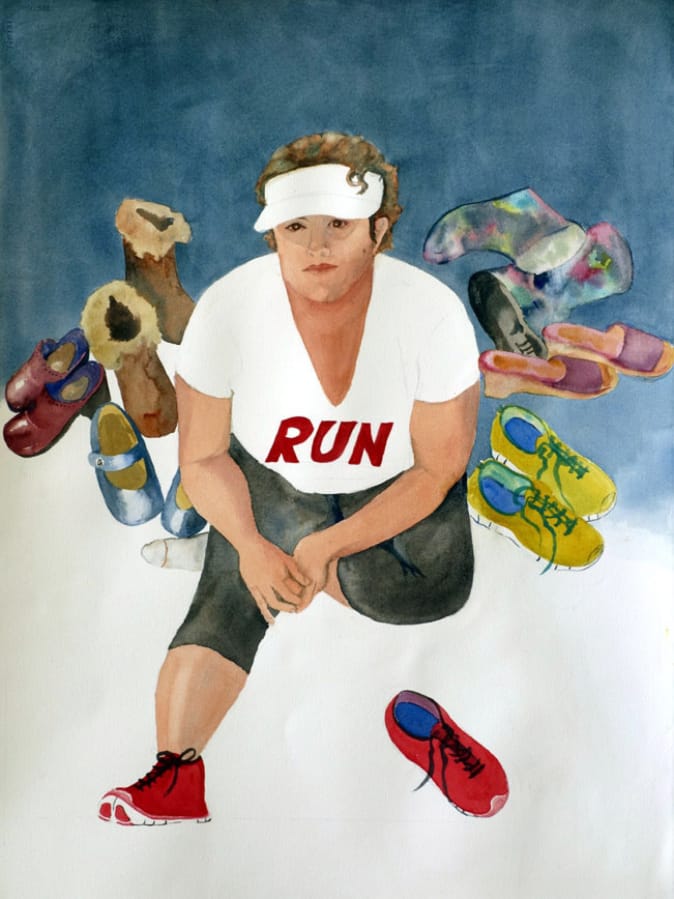It hurt Margaret Godfrey to see daughter Rachel Carter in pain, so she painted.
And once the worst pain had passed, Carter needed a way to move forward, so she wrote.
In 2000, at age 24, Carter was diagnosed with multiple sclerosis, a disease where the immune system eats away at the lining of nerves and impairs or disables the brain and central nervous system.
Carter is now a married 43-year-old mother of three who lives in Ridgefield. But when she was diagnosed with MS, it marked a significant shift in her life. The woman who ran marathons, rode a motorcycle to high school and was once a deckhand on a small riverboat cruise ship to prove a point because she was told a woman couldn’t hold that job, slowly morphed as her disease altered life.
It started with a fall on vacation during a run. Then falling on runs became more frequent. Gone went the marathons. In came the treadmill. Slowly, over the course of 12 years, the MS progressed and symptoms became debilitating. Running left completely. Neuropathic pain caused her to feel like she was sunburned in the morning, and by the afternoon or evening it felt like third degree burns. Carter left her job in sales in 2013.
“I would always end up in tears in the bed,” Carter said.
Carter has chronicled her battle with MS, and a stem cell treatment she credits with turning her prognosis around, in a new book called “Enduring the Cure: My MS Journey to the Brink of Death and Back.” Her mother helped her edit the book, and provided the book’s cover art. Adrienne van Der Valk also edited the book.
Through pain, Carter and her mother have created art. About five years ago, Carter underwent an experimental stem cell transplant in Seattle to help her rebuild her immune system. Carter lived in Seattle for about three months, while her parents watched two of her children, and the other child lived with an aunt.
As part of the procedure, Carter’s own stem cells were harvested and then reintroduced to her body after chemotherapy depleted most of her immune system. It’s what she described as a rebooting of her whole immune system, in hopes that it would stop attacking her brain and spinal cord. Carter still has her previous brain damage, which impacts her memory and brain power; but so far, the stem cell transplant has improved her condition greatly, she said.
Carter has more energy — she used to sometimes not be able to leave bed some days. She also can stand upright and walk easily — she used to rely on a walker. And her pain is minimal now, the biggest improvement.
Carter’s family kept notes during her treatment, and Carter decided to use those, and the memories of her family, to help her write the book with van Der Valk.
Thinking was very fatiguing for Carter, since she still has the brain damage from MS. She could only work about one to two hours on the book at a time. She said writing was frustrating and hard in many ways. “Parts of my brain are gone,” Carter explained. She said it requires her about 10 times as much brain matter as the average person to process something simple.
“It’s so much pressure to have something you feel like you have to do, and then you can’t do it. I had so little energy,” Carter said. “I can’t explain very well because so many words don’t come to me.”
In spite of the challenges, Carter feels like sharing her experience will help others because, “in life, we all have hard situations,” she said.
Godfrey, a 70-year-old painter who lives in Blue River, Ore., found art in the family’s experience. She drew inspiration from Gustav Klimt, an Austrian symbolist, who painted in the late 1800s and early 1900s, and created symbolic paintings of her daughter. Godfrey said art makes her an intellectual because of how she has to think about what she’s painting. This time she was researching her own child.
Godfrey did a painting of Carter surrounded by old running shoes, a life she had to give up. She did a painting of Carter without her hair, which centered on Carter’s worries. She did a painting of Carter covered by a quilt with her three kids on it, what kept her going and allowed her to recover. She did a painting of Carter lying in a hospital bed, looking exhausted and resigned, which is the book’s cover. The final painting in the series, called “The Journey Is Not Done,” features Carter with hair, months after treatment. It has an unfinished mosaic because Carter’s journey isn’t over.
“Creating art is a very meditative thing,” Godfrey said. “Rather than getting wrapped up in emotions, once I start painting the world is me and paper. All the worries of life disappear. It was a way to enjoy that experience of just being able to throw out my expression, without getting too emotionally tangled up.”




